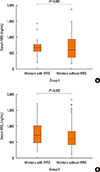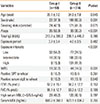1. Brisman J. Baker's asthma. Occup Environ Med. 2002; 59:498–502.
2. Quirce S, Diaz-Perales A. Diagnosis and management of grain-induced asthma. Allergy Asthma Immunol Res. 2013; 5:348–356.
3. Dykewicz MS. Occupational asthma: current concepts in pathogenesis, diagnosis, and management. J Allergy Clin Immunol. 2009; 123:519–528.
4. Malo JL, Chan-Yeung M. Agents causing occupational asthma. J Allergy Clin Immunol. 2009; 123:545–550.
5. Kwon SC, Song J, Kim YK, Calvert GM. Work-related asthma in Korea-findings from the Korea work-related asthma surveillance (KOWAS) program, 2004-2009. Allergy Asthma Immunol Res. 2015; 7:51–59.
6. Maestrelli P, Boschetto P, Fabbri LM, Mapp CE. Mechanisms of occupational asthma. J Allergy Clin Immunol. 2009; 123:531–542.
7. Houba R, Heederik D, Doekes G. Wheat sensitization and work-related symptoms in the baking industry are preventable. An epidemiologic study. Am J Respir Crit Care Med. 1998; 158:1499–1503.
8. Vandenplas O. Occupational asthma: etiologies and risk factors. Allergy Asthma Immunol Res. 2011; 3:157–167.
9. Hur GY, Koh DH, Kim HA, Park HJ, Ye YM, Kim KS, et al. Prevalence of work-related symptoms and serum-specific antibodies to wheat flour in exposed workers in the bakery industry. Respir Med. 2008; 102:548–555.
10. Guillen D, Barranco P, Palacín A, Quirce S. Occupational rhinoconjunctivitis due to maize in a snack processor: a cross-reactivity study between lipid transfer proteins from different cereals and peach. Allergy Asthma Immunol Res. 2014; 6:470–473.
11. Wiszniewska M, Walusiak-Skorupa J. Diagnosis and frequency of work-exacerbated asthma among bakers. Ann Allergy Asthma Immunol. 2013; 111:370–375.
12. Tsuchiya K, Siddiqui S, Risse PA, Hirota N, Martin JG. The presence of LPS in OVA inhalations affects airway inflammation and AHR but not remodeling in a rodent model of asthma. Am J Physiol Lung Cell Mol Physiol. 2012; 303:L54–L63.
13. Mac Sharry J, Shalaby KH, Marchica C, Farahnak S, Chieh-Li T, Lapthorne S, et al. Concomitant exposure to ovalbumin and endotoxin augments airway inflammation but not airway hyperresponsiveness in a murine model of asthma. PLoS One. 2014; 9:e98648.
14. Seo JH, Kim HY, Jung YH, Lee E, Yang SI, Yu HS, et al. Interactions between innate immunity genes and early-life risk factors in allergic rhinitis. Allergy Asthma Immunol Res. 2015; 7:241–248.
15. Kim SH, Hur GY, Jin HJ, Choi H, Park HS. Effect of interleukin-18 gene polymorphisms on sensitization to wheat flour in bakery workers. J Korean Med Sci. 2012; 27:382–387.
16. Cho HJ, Kim SH, Kim JH, Choi H, Son JK, Hur GY, et al. Effect of Toll-like receptor 4 gene polymorphisms on work-related respiratory symptoms and sensitization to wheat flour in bakery workers. Ann Allergy Asthma Immunol. 2011; 107:57–64.
17. Hur GY, Ye YM, Koh DH, Kim SH, Park HS. IL-4 receptor alpha polymorphisms may be a susceptible factor for work-related respiratory symptoms in bakery workers. Allergy Asthma Immunol Res. 2013; 5:371–376.
18. Tizaoui K, Kaabachi W, Hamzaoui K, Hamzaoui A. Association of single nucleotide polymorphisms in Toll-like receptor genes with asthma risk: a systematic review and meta-analysis. Allergy Asthma Immunol Res. 2015; 7:130–140.
19. Heitzeneder S, Seidel M, Förster-Waldl E, Heitger A. Mannan-binding lectin deficiency-Good news, bad news, doesn't matter? Clin Immunol. 2012; 143:22–38.
20. Nuolivirta K, He Q, Gröndahl-Yli-Hannuksela K, Koponen P, Korppi M, Helminen M. Mannose-binding lectin gene polymorphisms in infants with bronchiolitis and post-bronchiolitis wheezing. Allergol Int. 2012; 61:305–309.
21. Koponen P, He Q, Helminen M, Nuolivirta K, Korppi M. Association of MBL2 polymorphism with asthma after bronchiolitis in infancy. Pediatr Int. 2012; 54:619–622.
22. Nagy A, Kozma GT, Keszei M, Treszl A, Falus A, Szalai C. The development of asthma in children infected with Chlamydia pneumoniae is dependent on the modifying effect of mannose-binding lectin. J Allergy Clin Immunol. 2003; 112:729–734.
23. Bae SJ, Kim SH, Losol P, Yang EM, Park HS. Mannose-binding lectin 2 gene polymorphisms affect serum mannose-binding lectin levels in adult asthmatics. Ann Allergy Asthma Immunol. 2013; 111:71–73.
24. Birbian N, Singh J, Jindal SK, Joshi A, Batra N, Singla N. Association of the wild-type A/A genotype of MBL2 codon 54 with asthma in a North Indian population. Dis Markers. 2012; 32:301–308.
25. Aittoniemi J, Soranummi H, Rovio AT, Hurme M, Pessi T, Nieminen M, et al. Mannose-binding lectin 2 (MBL2) gene polymorphism in asthma and atopy among adults. Clin Exp Immunol. 2005; 142:120–124.
26. Kaur S, Gupta VK, Shah A, Thiel S, Sarma PU, Madan T. Elevated levels of mannan-binding lectin [corrected] (MBL) and eosinophilia in patients of bronchial asthma with allergic rhinitis and allergic bronchopulmonary aspergillosis associate with a novel intronic polymorphism in MBL. Clin Exp Immunol. 2006; 143:414–419.
27. Uguz A, Berber Z, Coskun M, Halide Akbas S, Yegin O. Mannose-binding lectin levels in children with asthma. Pediatr Allergy Immunol. 2005; 16:231–235.
28. Carréra MC, Moura P, Crovella S, de Souza PR, de Alencar LC, Sarinho E. High polymorphism of the MBL2 gene in patients with atopic dermatitis. Ann Allergy Asthma Immunol. 2010; 105:39–42.
29. Leung TF, Tang NL, Sung YM, Li CY, Ma SL, Lam CW, et al. Genetic association study between mbl2 and asthma phenotypes in Chinese children. Pediatr Allergy Immunol. 2006; 17:501–507.
30. Müller S, Keil T, Grüber C, Zitnik SE, Lau S, Wahn U, et al. MBL2 variants in relation to common childhood infections and atopy-related phenotypes in a large German birth cohort. Pediatr Allergy Immunol. 2007; 18:665–670.
31. Wang X, Saito J, Tanino Y, Ishida T, Fujita T, Munakata M. Mannose binding lectin gene polymorphisms and asthma. Clin Exp Allergy. 2007; 37:1334–1339.
32. Albert RK, Connett J, Curtis JL, Martinez FJ, Han MK, Lazarus SC, et al. Mannose-binding lectin deficiency and acute exacerbations of chronic obstructive pulmonary disease. Int J Chron Obstruct Pulmon Dis. 2012; 7:767–777.
33. Rantala A, Lajunen T, Juvonen R, Bloigu A, Silvennoinen-Kassinen S, Peitso A, et al. Mannose-binding lectin concentrations, MBL2 polymorphisms, and susceptibility to respiratory tract infections in young men. J Infect Dis. 2008; 198:1247–1253.
34. Lee SG, Yum JS, Moon HM, Kim HJ, Yang YJ, Kim HL, et al. Analysis of mannose-binding lectin 2 (MBL2) genotype and the serum protein levels in the Korean population. Mol Immunol. 2005; 42:969–977.
35. Hedrick PW. Gametic disequilibrium measures: proceed with caution. Genetics. 1987; 117:331–341.
36. Wills-Karp M. Complement activation pathways: a bridge between innate and adaptive immune responses in asthma. Proc Am Thorac Soc. 2007; 4:247–251.









 PDF
PDF ePub
ePub Citation
Citation Print
Print



 XML Download
XML Download